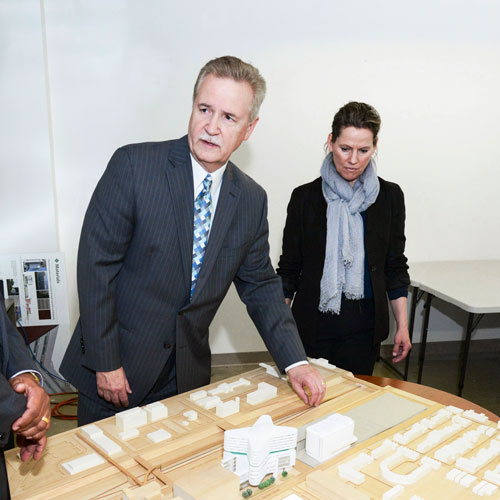Ed Prins makes something from nothing. He is director of real estate, planning, and strategy at Cemex, a global building-materials company, but he doesn’t use the building materials Cemex sells. Instead, he creates value from the property the company owns.
Cemex has approximately 1,100 locations in the United States, including quarries, cement plants, ready mix plants, cement terminals, and aggregate terminals. Prins takes an investment manager’s approach to the real estate, and when the investment ceases to create value, he finds a way to reimagine its worth. “What is exciting to me is being able to create value from what would normally be considered a corporate discard, or from a non-core business,” Prins says. “In Cemex’s case, we make cement, we make concrete, and we make aggregate. We also make surplus real estate.”
When one of Cemex’s quarries in Tucson had been mined out, Prins had to find a new use for the land, which had originally belonged to Rinker Materials, a heavy-building-materials company that Prins began working for in 2006. In July 2007, Cemex acquired Rinker, and Prins took over the real estate function for both companies. Instead of letting the mined-out quarry sit empty, he saw it as a development opportunity.
Quarry Pines
Prins and his team sold off the surrounding land to a home developer and developed the quarry itself into a golf course, thereby transforming the property from a money pit into a money-making opportunity. The golf course was originally called the Pines, but Prins wanted its name to evoke its unusual past. It is one of five golf courses built from former quarries in the United States, and this fact alone draws golfers to the location.
“People look for experiences,” Prins says. “They look for something that is unique, and this was an opportunity to create something like that.” The owners renamed the course Quarry Pines, which both suggests its history and is a play on Torrey Pines, a famous golf course in California.
Throughout his career, Prins has often heard companies say that they “dispose” of surplus real estate. Prins avoids this term, which he says disregards the asset’s worth. “We wouldn’t dispose of our cement,” he says. “We wouldn’t dispose of our aggregate or concrete. We sell our concrete based on the cost of the goods sold, what profit we can make, and what we believe the customer is willing to pay us. So, why not look at your surplus real estate and ask those same questions?”
Convincing management to reimagine the company’s scope is made easier by the impact Prins’s approach has on the bottom line. In his 11 years at Cemex, he has sold more than $260 million worth of real estate. “That’s free cash flow that goes to the corporation from things that they might not have thought about,” he says. “If we had an empty pit that we were paying carrying costs on, including property taxes and maintenance, that would be painful. As long as we’re making money, it’s not painful.”
With Quarry Pines, Prins developed a depleted quarry into a viable business, but in other cases, he creates and sells a vision. When a Tucson sand mine had been mined out, Prins again looked at the property’s potential rather than its history.
The former sand mine is located on a major intersection at Tucson’ southern entry point, 60 miles north of the Mexican border. It’s a promising location, but selling the real estate is not as simple as putting up a for-sale sign and waiting for a buyer to appear.
Find the Hook
As with any other product, Prins markets the real estate by putting a package around it and targeting its selling points to a buyer’s needs. He likens it to the marketing done on Madison Avenue, using toothpaste as an example. “You go to your local drugstore and you say, ‘I want a toothpaste that is going to fight cavities,’ or ‘I want a toothpaste that will whiten my teeth,’” he says. “You see a box that says tooth whitening or cavity protection. That box is what catches your attention because you, as the customer, have a need, and that box solves your need.”
Prins and his colleagues worked closely with one of Tucson’s city councilmen to advertise the former sand mine property in a way that would address the city’s goals and Cemex’s. The councilman wanted to see jobs and housing, so Prins and his colleagues developed a vision for the space that focused on those drivers and took it to market.
“They say a picture’s worth a thousand words, and in our case, it really is,” he says. “The picture we painted is not just of a former sand mine. We’re painting a picture of big-box retail that is oriented to the Mexican border. We’re painting a picture of light industrial that is focused on the air force base—which is across I-19 from us—and the border and the Tucson airport.”
By connecting the property’s assets with the customer’s needs, Prins reframes his investment’s value and creates an asset for both Cemex and the buyer. “There’s a reason that this company bought this property to begin with or built the business to begin with: because it was valuable to them,” he says. “So, the question was, how could we make that property valuable to someone else? You don’t just put five pounds of toothpaste on a shelf and say, ‘Come find me.’ There’s got to be a hook.”
Photo: Scott Rich
Congratulations to our friend Edmond “Ed” Prins and CEMEX USA for their well-deserved recognition as leaders in business innovation. Inventure Design is proud of the relationship between our firms. We look forward to continuing to provide you with inventive design solutions for years to come.


